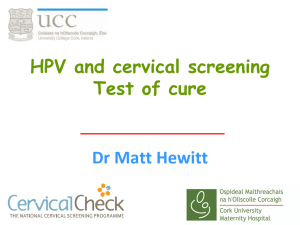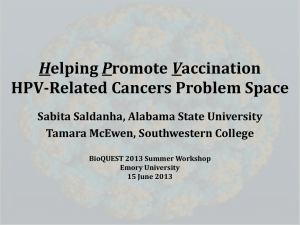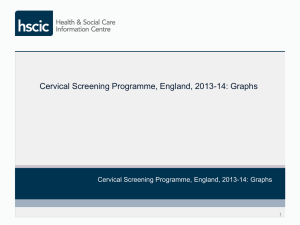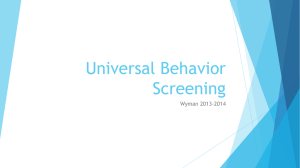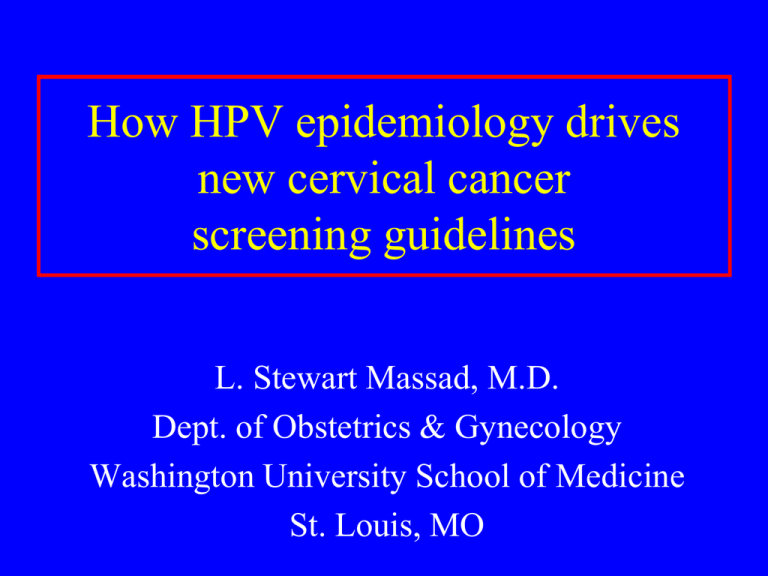
How HPV epidemiology drives
new cervical cancer
screening guidelines
L. Stewart Massad, M.D.
Dept. of Obstetrics & Gynecology
Washington University School of Medicine
St. Louis, MO
Disclosure
• I do not have financial relationships with
pharmaceutical or device manufacturers
• This talk does not include unapproved uses of
tests
• I have received honoraria and expense
reimbursement from ASCCP for guidelines
development.
• I have received payment for malpractice
consultation (defendants and plaintiffs)
Learning objectives
• Participants should be able to screen
women for cervical cancer, applying the
epidemiology and natural history
– of human papillomavirus infections
– and of consequent preinvasive/invasive
cervical lesions
that underlie new guidelines
What is the objective of screening?
• To reduce morbidity/mortality from cancer
– Not to find abnormal Paps or CIN
– Not to find HPV infection
• While minimizing harms from overdiagnosis
Requires balancing sensitivity/specificity
Use a sensitive screen at long intervals to
allow regression of self-limited lesions
Why isn’t finding lesions the
objective of screening?
• CIN/SIL/HPV are surrogate markers, not
inevitable cancer precursors
• Finding CIN/SIL/HPV not destined to
cause morbidity/mortality
– Increases anxiety, stigma, treatment pain and
complications, and cost
– Without benefit to patients
Why isn’t finding lesions the
objective of screening?
• We can’t tell which lesions will progress.
• But we know we want to target only:
– Persistent HPV infections
– CIN 3 (no margin for error)
– CIN2 in older women (no risk to pregnancies)
– Persistent CIN2 and CIN2,3 in younger women
Reducing cervical cancer risk to
zero is not feasible
• Consensus focuses on level of risk that is
acceptable vs harms of screening
• Some cancers are not preventable:
– Rapid onset cancers in women 20-30yo
– Tight gap junction neoplasms that don’t exfoliate
– High grade lesions with low level HPV
Annual cancer risk, US women
ACS: Ca:Cancer J Clin 2014;64:10
Incidence Mortality
Breast
Lung
Colon/rectum
Uterine corpus
Ovary
Cervix
Vulva/vagina/other gyn
235,030
108,210
65,000
52,630
21,980
12,360
8,020
40,000
72,330
24,040
8,590
14,270
4,020
1,910
Current cervical cancer risk is low
15-19yo
20-24yo
25-30yo
30-34yo
35-39yo
CaCx rate/100,000
U.S. women
0.2
2.6
7.8
11.4
14.4
SEER 1992-96, all races: Risk in Africa is >30
Agestandardized
cancer
incidence and
mortality are
low in
regions with
screening.
Ca Cancer J Clin
2011;61:69-90
Residual risk
• >40,000,000 Paps annually in US
• >2,000,000 abnormal Paps annually (5%)
• >200,000 CIN2,3 annually (0.5% of all
screens)
Many are cancers that screening/Rx will prevent
Cancer risk in unscreened women remains high
Residual risk
• >50% of cervical cancers occur in un- or
underscreened women
• About 1 in 8 cancers follow mismanaged
abnormal screening tests
Only ~30% of cancers are screen failures
A perfect screening test will save 1000 lives
among 40,000,000 women screened
Spence et al. Prev Med 2007;45:93-106
HPV and cervical cancer
All cervical cancer is due to HPV infection
but few HPV infections lead to cervical cancer
• >60% of women contract HPV within 2y of first sex
– Most contract carcinogenic types, esp. HPV 16
• 90% clear HPV within 2 years of infection
• But only persistent high risk infections cause cancer
– HPV- women at low short term risk, even if prior infected.
Why new guidelines?
CIN2+ in <30% of women with HPV+ ASC-US and LSIL
• True despite HPV being found in 100% of HPV+
ASC-US, 85% of LSIL
Thus, most abnormal Paps represent benign HPV
infections that will clear, not precancer
HPV cumulative incidence among women
sexually active but HPV- at enrollment
Winer R L et al. Am. J. Epidemiol. 2003;157:218-226
Weighted prevalence of low-risk and high-risk HPV
among US women 14–59yo, CDC
Hariri S et al. J Infect Dis. 2011;204:566-573
30-month rates of clearance/persistence/progression of
oncogenic HPV among women <30yo, US NCI, Guanacaste
Rodriguez AC et al. JNCI 2008;100:513-7
Rapid clearance of HPV in Women >30
8%
*
61%
* Histological progression
Rodriguez AC et al. J Natl Cancer Inst. 2008;100:513-17.
CIN behavior mirrors HPV
• >75% of CIN1 regress without treatment
• Only 10% develop CIN3 within 2y (no cancers)
• Most rapid-onset CIN are HPV infections with
little neoplastic potential
• >65% of adolescents clear CIN2 within 3y
• >50% of adults clear CIN2 without treatment
What is the natural history of
LSIL/CIN1 in adolescents?
Moscicki AB et al. Lancet 2004;364:1678-83
Similar high
likelihood of
clearance of newly
acquired HPV in
young women
Franco E L et al. J Infect Dis. 1999;180:1415-1423
Early screening may be futile
• Better grasp of the futility of early screening
– “Cervical cancer screening has little or no impact
on rates of invasive cervical cancer up to age 30.”
Many European health programs delay screening
till 25-30 years of age
» Sasieni et al BMJ 2009;339:328
Short Pap intervals = more
colposcopy, little added benefit
• Screening harms: lifetime risk of colposcopy
– Screening q3y: 760 colpos/1000 women
– Screening q2y: 1080 colpos/1000 women
– Screening annually: 2000 colpos/1000 women
Stout NK et al. Arch Intern Med 2008;168:181.
Kulasingam S et al. 2011. AHRQ Publication No.11-05157-EF-1.
5y CIN3+ risk after neg cotest similar to
1y risk after neg Pap
Dillner J et al. BMJ 2008;337:a1754
Treatment saves but also costs lives
Women with LEEP more likely to have
Preterm birth (O.R. 1.7)
LBW (O.R. 1.8)
PPROM (O.R. 2.7)
Single studies show association with perinatal death,
incompetent cervix
Risk rises with depth, # LEEPs
Similar findings after CKC or laser cone
Absolute risk increase is small
Kyrgiou M et al. Lancet 2006;367:489-98 and Bruinsma et al BJOG 2007;114:70-80
Consensus Conference
Sponsored by
• American Society of Colposcopy and
Cervical Pathology (ASCCP)
• American Cancer Society (ACS)
• American Society of Clinical Pathology
(ASCP)
ACS/ASCCP/ASCP guidelines
development process
• 2009-2011: 3 organizations created 6 working
groups as well as a data group to aid in literature
review and evidence evaluation
• Participating organizations:
AHRQ, AAFP, ABOG,ACHA, ACOG, ASHA,
AmSoc Cytopath, AmSoc Cytotech, CDC, Ctrs for
Medicare/Medicaid, CAP, FDA, NCI, NCCN,
NPWH, PPFA, SCC, SGO, SGOC, USPSTF,
Veterans Health Admin
ACS/ASCCP/ASCP guidelines
development process
After formal evidence review
• Recommendations posted to ASCCP website for
public comment 10/19-11/9/11
– Revisions made based on comments as needed
• Consensus conference 11/17-18/11
• After discussion, recommendations approved by at
least 2/3 majority
ACS/ASCCP/ASCP guidelines
development process
Assumptions
• Benefits of screening
– Cancer is the ideal endpoint but unrealistic
– CIN3 is a reliable surrogate marker for
sensitivity
– CIN2 is hard to diagnose, often regresses: not a
target for screening, though still a target for
treatment
ACS/ASCCP/ASCP guidelines
development process
Assumptions
• Screening interval
– Development of invasive cancer should be
unlikely before next screen
– Earlier detection of CIN3+ is a benefit
• Even if studies of less sensitive tests show similar
CIN3 detection, no increased cancer risk during
later screening rounds
ACS/ASCCP/ASCP guidelines
development process
Assumptions
• Harms of screening
– Anxiety over a positive test
– Stigmatization
– Pain/bleeding from procedures
– Treatment-related pregnancy loss
– Number of colposcopies is a marker for these
ACS/ASCCP/ASCP guidelines
development process
Assumptions
• Preventing all cervical cancer is unrealistic
– No test has 100% sensitivity
• Reasonable risk is determined by the strategy of
cytology alone at 2-3y intervals
– Screening strategies with similar results acceptable
• Women at similar risk for cancer should be
managed similarly
ACS/ASCCP/ASCP guidelines
development process
Assumptions
• Conventional/liquid-based Paps perform similarly
• HPV tests should have ≥90% sensitivity for
CIN3+ and CIN2+
– Comparability of FDA-approved HPV tests can’t be
assumed
– Utility of unapproved/exempt tests is unknown
• These should not be used in screening
Changes from 2002 guidelines
• Retains 21yo start to screening
– No longer 3y after sex or 21yo, as before 2002
• Longer Pap screening intervals
– Screen q3y ages 21-29—was annually
– Screen q3y 30-65
• New technology allows long interval:
– Cotesting preferred q5y over Paps
• Stop at age 65, not 70
– Retains guideline to stop after hyst for benign disease
When to start screening
• “Begin at age 21 years”
• Younger women “should not be
screened regardless of the age of
sexual initiation or other risk factors.”
Rationale for later screening start
• Cervical cancer rare in teens (<1:1,000,000)
• Early onset CaCx may not be preventable
• HPV—including HRHPV—occurs in over
80% of sexually active adolescents
• HPV infections usually transient
Others start screening later
• Europeans begin screening at 25-30 years of
age
– Screen only every 3-5 years
– But they have central screening systems with
organized recall
When to start screening
• Avoid screening adolescents
– Cancer risk low
– Abnormalities may prompt treatment for lesions
likely to resolve
• Sexually active adolescents need care for
contraception and STD screening/treatment
– These don’t require Pap testing
– No speculum needed for asymptomatic women
– STD testing can be done using urine
Screening intervals
• Ages 21-29
– Cytology alone q3y
– HPV testing “should not be used to screen”
• Not as a component of cotesting
• Not as a primary stand-alone screen
Rationale for longer intervals
• Sensitivity of single Pap smear only 50-70%
– Cancer risk 18mo after 3 neg Paps = 1.5/100,000
– Cancer risk 36mo after 3 neg Paps = 4.7/100,000
99,997 women screened uselessly to help 3
• Risk of HSIL/cancer <3y after negative Pap not
significantly higher than risk after 1y
• Longer Pap screening intervals (e.g., 5y)
inappropriate for mobile US population
Sawaya GF et al. Acta Cytol 2005;49:391-7
Rationale for avoiding HPV tests
• Prevalence of carcinogenic HPV approaches
20% in teens-early 20s
• Most carcinogenic HPV infections resolve
• Identifying carcinogenic HPV that will resolve
leads to repeated call-back, anxiety,
interventions without benefit
• May be useful in follow-up, esp after
treatment
Screening intervals
• Ages 30-65
– Cotesting (cytology + HPV test) q5y (preferred)
– Cytology alone q3y (acceptable)
Why prefer cotesting?
• Adding HPV tests to cytology
– Increases detection of prevalent CIN3
– Decreases CIN3 in subsequent screening rounds
– Therefore lower risk after neg screen
– So a 5y interval between screens achieves risk of
CIN3 equal to that after cytology alone done at 13y intervals
Why prefer cotesting?
• Adding HPV tests to cytology
– Enhances detection of adenocarcinoma/AIS
• Increasingly prevalent yet often missed by Pap alone
– Q3y vs q5y cotests: 10y cancer risk for 40yo
woman was about 0.6%
– Extending screening to q5y minimizes
colposcopies, so reduces harms of a more
sensitive test.
Why not require cotesting?
• Some sites may lack access to HPV testing
• Financial, logistical
• Cytology remains effective
– It just requires more frequent visits with more risk of
loss to follow-up, more colposcopy for equivocal
results
Why not annual cotesting?
• High NPV of one cotest means most
abnormal screens at 1-3y intervals represent
transient HPV infection, not precancer
• Harms are amplified for minimal benefit
When to stop screening
• Stop at age 65 for women with adequate
negative prior screening, no CIN2+ within
the last 20y.
• Screening “should not resume for any
reason, even if a woman reports having a
new sexual partner.”
When to stop screening
• Adequate negative prior screening is defined
as
–
–
–
–
3 consecutive negative cytology results or
2 consecutive negative cotests
within the 10 years before ceasing screening
with the most recent test within 5 years.
Rationale for stopping at 65yo
• CIN2+ is rare after age 65
– Most abnormal screens, even HPV+, are false
positive, i.e., don’t reflect precancer
• HPV risk remains 5-10%
• Colpo/biopsy/treatment more difficult
– Harms are magnified
• Incident HPV infection unlikely to lead to cancer
within remaining lifetime
Chen HC et al. JNCI 2011;103:1387-96. Rodrigues AC et al. JNCI 2009;101:721-8
Rationale for stopping after hyst
• Vag cancer rate is 7/million/yr
• 663 vag cuff Paps needed to find one VAIN
• 2066 women followed after hyst for avg 89mo
– 3% had VAIN, 0 had cancer
• Risk of Pap abnormality after hyst = 1%
– Most abnormal screens, even HPV+, are false
positive, i.e., don’t reflect precancer
– Equal risk of breast cancer in men--mammography?
Pearce KF et al. NEJM 1996;335:1559-62. Piscitelli JT et al. AJOG 1995;173:424-30
When to stop screening
• Stop at hysterectomy with removal of cervix
and no history of CIN2+
• “Evidence of adequate negative prior
screening is not required”
When NOT to stop at 65yo
• History of
– Prior Cervical or endometrial cancer
– In utero DES exposure
– HIV infection or other immunocompromise
• If Hx CIN2, CIN3, or AIS
– Continue “routine screening” for at least 20
years, “even if this extends screening past age
65.”
Screening after treatment of CIN2+
• 2012 Management algorithm recommends
“Routine screening” after 3 negative cotests
– How to manage after prior Paps/no cotests?
– Stop at age 65?
– Stop after hysterectomy for CIN2+?
Management of Women with Biopsy-confirmed Cervical Intraepithelial Neoplasia Grade 2 and 3 (CIN2,3) *
Adequate Colposcopy
Inadequate Colposcopy or
Recurrent CIN2,3 or
Endocervical sampling is CIN2,3
Either Excision† or
Ablation of T-zone *
Diagnostic Excisional
Procedure †
Cotesting at 12 and 24 months
2x Negative
Results
Repeat cotesting
in 3 years
Routine screening
Any test abnormal
*Management options will vary in special
circumstances or if the woman is pregnant
or ages 21-24
†If CIN2,3 is identified at the margins of
an excisional procedure or postprocedure ECC, cytology and ECC at
4-6mo is preferred, but repeat excision
is acceptable and hysterectomy is
acceptable if re-excision is not feasible.
Colposcopy
With endocervical sampling
© Copyright , 2012, American Society for Colposcopy and Cervical Pathology. All rights reserved.
Screening after treatment of CIN2+
• Evidence is unclear
• How to manage after prior Paps/no cotests?
– Consider 2-3 Paps = 1 cotest (so annual Paps x
10y should convey similar risk)
• Stop at age 65? ACOG: continue at least 20y
– Judgment: Stop only if multiple prior neg screens
• Stop after hysterectomy for CIN2+?
– Judgment: Only if multiple prior neg Paps
– Avoid cotesting: meaning of Pap-/HPV+?
Primary HPV screening
• Expert panel voted 3/12/14 to recommend
–
–
–
–
Requires cobas HPV test in ThinPrep media
Start age 25
Interval uncertain (SGO/ASCCP writing guidance)
Sensitivity is high, specificity good if:
Summary: the 2011 standards
USPSTF
When to start? 21yo
ACS/ASCCP/ASCP
21yo
How often?
Q3y Paps ages 21-29
Q5y cotest ages 30-64 preferred
Q3y Paps remain an option
Q3y Paps
Q5y cotests
ages 30-64
When to stop? 65yo if
65yo if 3 neg Paps or 2 neg cotests
adequate
After hyst for benign disease
prior screens
Conclusion
• “Perhaps the largest immediate gain in
reducing burden of cervical cancer
incidence and mortality could be attained by
increasing access to screening (regardless of
the test used) among women who are
currently unscreened or screened
infrequently.”
ACS, 20012


